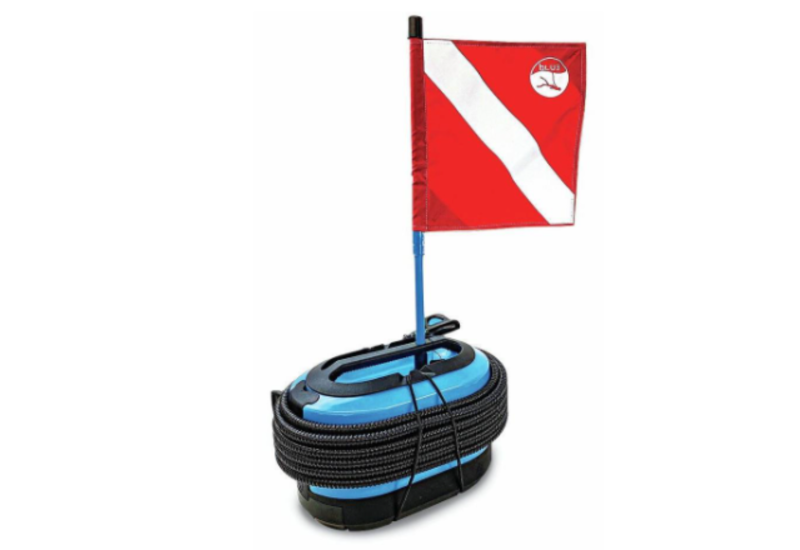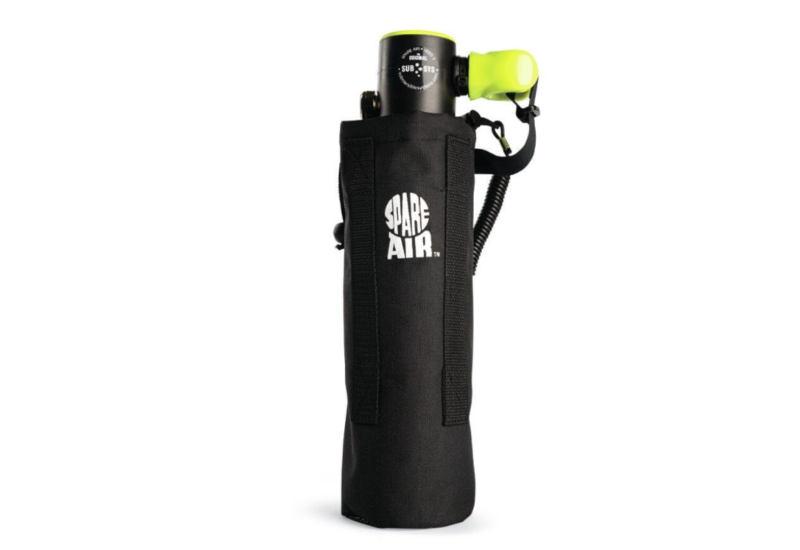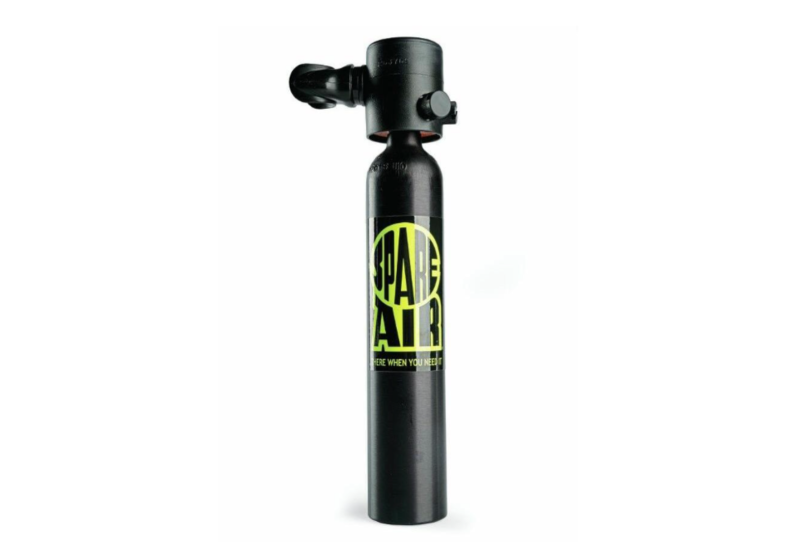Regulator Durability
January 2007
By John Brumm
Photography by Joseph Byrd
||
|---|
|

|
Of all the gear divers need, by far the most important item is the regulator. Indeed, it was the singular invention of the open-circuit scuba regulator that made diving as we know it possible. And since its introduction over a half-century ago, engineers have made such remarkable technological advances in performance that some experts say regulators aren't likely to get much better without a quantum leap in technology.
But what about durability? When mechanical products get more advanced, they often get more complex, which means there's more to go wrong. Does this apply to regulators? Scuba Lab decided to find out.
The Regs
| 30 Hours Aeris A1 Aeris Atmos Pro Atomic Aquatics T1x Dive Rite RG2500 Oceanic Alpha 8/SP-5 Oceanic GT 3/CDX-5 Tusa RS-460 50 Hours Atomic Aquatics B2 Atomic Aquatics T2 | Genesis Scuba GS2000 Oceanic Delta 4/FDX-10 Sherwood Scuba Brut XS Scuba SeaAir Tri-Metal 100+ Hours Aeris Atmos Sport Atomic Aquatics M1 Atomic Aquatics Z1 Sherwood Scuba Oasis Tusa RS-110 |
The Challenge
In late 2004, we invited a number of reg manufacturers to participate in the first-ever long-term test of regulator durability. The response was overwhelmingly positive, so much so that we had more takers than we had available spots. In the end, we collected 18 regs that represented the range of breathers on the market.
To establish a baseline of performance, we first put them all on the ANSTI breathing machine. The ANSTI machine is an amazing tool, capable of measuring very minute differences in the work of breathing (WOB) at a variety of breathing rates and at a variety of depths. Specifically, it measures in joules per liter (j/l) the breathing resistance created by the regulator over the course of a complete inhale/exhale cycle. The lower the j/l measurement, the easier the reg breathes, but while the machine can measure performance differences as little as .01 j/l, the average human being probably can't discern a difference of less than .5 j/l.
Using a trimmed-down version of Scuba Lab's standard breathing machine protocol, we captured work of breathing data at two breathing rates/depth levels: 37.5 RMV at 132 feet (a somewhat aggressive breathing rate at the maximum recreational diving depth), and 62.5 RMV at 165 feet (the breathing rate and depth most commonly used by manufacturers to test regulators). In case you're wondering, RMV stands for respiratory minute volume, and the number represents how many liters of air are inhaled and exhaled in one minute.
Time to Get Wet
||
|---|
|

|
| A volunteer checks out a test reg from Dive Safety Officer Vallorie Hodges.|
Our next stop was the Oregon Coast Aquarium, a world-class marine life facility located in the coastal town of Newport, Ore. The saltwater aquarium offered controlled conditions that simulated the ocean environment and a team of 82 divers who spend a lot of time breathing underwater (see: "The Testing Ground"). Under the supervision of Dive Safety Officer Vallorie Hodges, the divers went about their normal aquarium duties, only they used our test regs instead of their own. To meet the aquarium's safety standards, each test reg was fully equipped with an SPG and octopus reg donated by Sherwood Scuba.
-
Virtually all regs experienced a small change, usually a reduction, in their first-stage intermediate pressure. This is to be expected, however, as normal wear and use takes its toll on the soft and hard seats--parts that are intended to be inspected and replaced during normal servicing.
-
Among the seven regs that logged approximately 30 hours, there was no substantial change in their work of breathing scores when compared to the pre-dive tests on the breathing machine. The one reg that did register a noteworthy change turned in a post-dive performance drop of less than half a joule. This is a small change that an average diver probably wouldn't be able to discern.
-
Among the six regs that logged approximately 50 hours, five turned in the same breathing machine performance before and after the 18 months at the aquarium. The sixth reg actually registered a slightly better performance. However, the improvement measured less than half a joule, which would not be noticeable to a typical diver.
-
Of the five regs in the 100 hours or more category, only two models experienced a performance drop that would have been detectable by a diver. Of these two, one showed seriously decreased performance due to mechanical difficulties in the first stage that were later corrected on the repair bench (see below). The other saw slightly diminished performance only in the most demanding ANSTI test and was brought back to its original performance level once it received long-overdue routine servicing.
On the Rebuild Bench -
In general, all of these regs held up very well, even those with well over 100 hours logged. Overall, the level of corrosion was minimal, ranging from none to light. No salt crystals were found in the internal components, and wear on the internal parts was generally considered to be acceptable. Wear and tear on hoses, mouthpieces, dust caps, and O-rings, etc., was also acceptable.
-
The most significant signs of wear were found on the two regs that logged the highest number of hours. One reg developed a thin but visible crack in its plastic second-stage case at the hose inlet, most likely the result of lateral stress on the hose or a hard blow to the case. While it did not affect breathing performance and wasn't noticed by the test divers, the cracked case presented a possible failure point and required replacement. The other reg experienced a rare but potentially serious problem with its first stage balancing system that made it unable to adapt to pressure changes on descent. In the shallow aquarium environment, test divers didn't notice a problem, but had they been diving any deeper, this reg's work of breathing would have quickly become extremely difficult and would have increased with every foot of depth. The problem was easily detected on the repair bench, but fixing it required a replacement part not normally included in the basic rebuild kit.
-
A half-dozen regs also showed some slack in their second-stage demand levers. While this could be the result of wear during the test, it could also be caused by improper factory adjustment, the nature of each reg's design or the use of too-weak springs. We did not tension-check each reg's demand lever prior to use, so we can't say for sure. In all cases, however, the slack was correctable on the rebuild bench.
Hodges set up a tracking system that enabled divers to easily sign out a reg for each dive session and log the time the reg was actually used. After each dive session, the still-pressurized regs were soaked in a clean freshwater rinse tank (the tank water was changed daily) for 15 minutes. The aquarium divers used egg timers to track soak time and when the bell went off, the regs were rinsed under a gentle stream of fresh water before being depressurized and removed from their cylinders. The dust caps were dried with a towel and replaced on the first stages. Regs were then gently shaken dry and placed on grated shelving where they remained until the next time they were used. This soak/rinse process generally follows the standard after-dive maintenance instructions found in virtually all the manuals of our test regs.
Time's Up
For 18 months, the aquarium divers went about their duties, breathing the regs and logging the hours. When this phase was complete, Hodges assembled all data sheets, collected all the regs and sent everything back to Scuba Lab. We then went back to the ANSTI breathing machine and repeated the same panel of breathing tests as before to see if there was any change in performance. For our final step, we sent the regulators to the most qualified reg technician we know--George Perez, the owner of Sea Divers, in Ozark, Ala.--for a tear-down inspection and complete rebuild.
To help get a real-world handle on the following results from both the ANSTI machine and the rebuild bench, we divided the regs into three use categories defined by the number of hours accumulated during the in-water phase of the test.
30 hours: Representing a relatively active diver who might get out for a two-tank day of local diving once a month, and maybe take one dive vacation a year.
50 hours: Representing the more aggressive dive junkies among us who might spend a couple days a month sucking down two or three tanks each day, or take more than one dive vacation in a year.
100-plus hours: Representing the bona fide dive gorillas who seem to spend as much time underwater as they do on the surface (you know who you are).
The Results
On The ANSTI Machine
The Bottom Line
Our first-ever regulator durability test added iron to two scuba maxims. One, a modern regulator is a rugged piece of equipment, able to provide reliable service for many hours of diving. Which brings us to maxim number two: Nothing has a greater impact on the life and well-being of your regulator than how you maintain it--after each dive and for the long haul.
The regs we turned over to Perez had more accumulated hours than the average recreational regs that cross his repair bench for annual servicing, yet they had fewer corrosion issues. The difference, he says, is the thorough soak and rinse they got after every dive. While our rinsing procedures are consistent with virtually all manufacturers' recommendations for post-dive care, let's be honest, they aren't consistent with what most of us actually do after a dive. Our advice: Take better care of your reg. A thorough soak and rinse will keep it at peak performance and increase its reliability.
Second, follow the manufacturer's recommendations when it comes to regular service intervals. For most of the regs on the market today, that means taking it to a qualified technician every 12 months (see the chart on p. 71). We skipped that service interval in the process of putting these regs to the test over an 18-month period, but that doesn't mean you should. The few performance issues we uncovered were all preventable with routine service.
In short, your regulator is your primary life-support system. Treat it with the respect it deserves, and you will protect your investment and maybe even save your life. But don't take our word for it. We now have test data to prove it.
The Testing Ground
||
|---|
|

|
| Cleaning the glass windows and observation tunnels is one of the labor-intensive chores that keeps volunteer divers busy.|
The Oregon Coast Aquarium not only provided the perfect saltwater environment for our test of regulator durability, it also provided a can-do team of test divers who made it all possible. The 82 aquarium divers (55 men, 27 women) are a mix of staffers and volunteers who worked skillfully under the supervision of Dive Safety Officer Vallorie Hodges and we thank them for their strict adherence to our test protocols.
We thought you'd like to know a little bit more about the aquarium's volunteer divers. For starters, they all hold advanced open-water or higher certifications, and all had to complete the aquarium's four-day training course just to join the aquarium's dive team. On average, their one-way commute to the aquarium is about two-and-a-half hours, either through summer tourist traffic or blustery winter weather, just so they can spend the day assisting the aquarium's staff with the husbandry needs of the animals. This may include feeding fish, picking up waste, wiping down viewing windows, or mugging for the tourists who seem to enjoy watching the divers as much as they do the sharks, halibut, wolf eels, and variety of other animals. Even with all the chores that need to be done, the Oregon Coast Aquarium is still a fun dive. According to the volunteers, it's the bar-none best shore dive in the state, guaranteeing no shore break, good vis and lots of animals to swim with. For more on the Oregon Coast Aquarium, visit www.aquarium.org.
Manufacturer Warranty And Service Protocol
| Regulator Durability | |||||
| Manufacturer / Model | Recommended Service Interval | Warranty | Parts Program | First Stage Rebuild Kit Price* | Second Stage Rebuild Kit Price* |
| Aeris A1 † | 12 months or 100 dives | 2-yr. ltd. | Free lifetime replacement parts program available. | $13-$15 | $9 |
| Aeris Atmos Pro † | $20 | $11 | |||
| Aeris Atmos Sport † | $20 | $9 | |||
| Atomic Aquatics T2 | 24 months or 300 dive hours | Ltd. lifetime | Free replacement parts for first two years. | $20 | $12 |
| Atomic Aquatics T1x †† | $20 | $12 | |||
| Atomic Aquatics B2 | $22 | $12 | |||
| Atomic Aquatics M1 | $22 | $12 | |||
| Atomic Aquatics Z1 | $22 | $12 | |||
| Dive Rite RG2500 | 24 months or 100 dives | Ltd. lifetime | Free lifetime replacement parts available. | $29.06 | $14 |
| Genesis Scuba GS2000 | 12 months | Ltd. lifetime | Free replacement parts for first two years. | $20 | $10 |
| Oceanic Alpha 8/SP-5 ††† | 12 months | 2-yr. ltd. | Free lifetime replacement parts program available. | $12-$15 | $10 |
| Oceanic GT 3/CDX-5 ††† | $20 | $10 | |||
| Oceanic Delta 4/FDX-10 | $20 | $11 | |||
| Sherwood Scuba Brut | 12 months | 2-yr. ltd. | Free replacement parts during term of warranty. | $8.50 | Included in 1st stage price |
| Sherwood Scuba Oasis | |||||
| Tusa RS-110 †††† | 12 months | Ltd. lifetime | Free lifetime replacement parts program available. | $18 | $6 |
| Tusa RS-460 | $28 | $7 | |||
| XS Scuba SeaAir Tri-Metal | 12 months | Ltd. lifetime | No free parts program. | $18 | $12 |
| * These are typical retail prices for the basic service kits. Prices may vary by repair facility and do not include additional items such as mouthpieces, packing lubes, shims, etc., that may also be required. Prices do not include labor charges. † The A1 is now available with or without a Dry Valve Technology (DVT) first stage. The Atmos Pro and Atmos Sport are now sold as the AT400 Pro and AT400 Sport, respectively, both with the AT400 first stage, which incorporates DVT. †† The Atomic Aquatics T1x is no longer in production. ††† The SP-5 first stage is available with or without DVT. The CDX-5 first stage now includes DVT. †††† The RS-110 will be replaced by the new RS-520 in 2007. |
Regulator Warranties
One clear finding from this project is the importance routine maintenance can play in keeping your reg at peak performance. While these regs stood tall in the face of extended use, Scuba Lab still recommends you follow the manufacturers' recommendations for regular servicing. The small investment in maintaining your life-support gear can pay big dividends in performance. The suggested retail price of the replacement parts kits for the regs in this review ranges from about $10 to $45, but many warranties cover the cost of parts if you service your reg at the recommended intervals. Labor charges will vary.
How much labor is involved? It depends on the regulator design and the condition the reg is in when it comes into the shop. Here is the procedure George Perez used for this review and that he follows whenever a reg comes to his shop for annual service. Not every shop is this thorough, but maybe they all should be.
Annual service protocol
"When I start with a unit I check it externally for corrosion, cracks, and missing or misplaced parts. I remove the mouthpiece and place it in a sterilizing solution. I then attach the first stage to a cylinder valve adjusted to 3,000 psig. I record the intermediate pressure (IP) and then the Magnehelic reading of the cracking effort (CE). I then place the second stage on a Peter Built A.I.R. Flow analyzer and confirm the IP and CE, then check for water leaks.
"Next I review the individual regulator's service manual and note procedures for disassembling, cleaning, re-assembling and tuning. I then check the manufacturer's web site for any warnings, cautions or notices.
"The unit is then completely disassembled, while I make notes on corrosion and worn or broken parts. All parts are washed in soapy water (Dawn dishwashing liquid), and when necessary to remove corrosion, they are placed in an ultrasonic cleaner using Lawrence Factor Wash. After ultrasonic cleaning the parts are placed in a neutralizing solution, washed in water and blown dry.
"Assembly is performed per the instructions in the service manual, using the manufacturer's service kits.
"Preliminary tuning, in accordance with the manufacturer's data, is done at low pressure (500 psig) and then at high pressure (3,000 psig). The unit is then put on a Peter Built Quick Set Seat and Poppet fixture to break-in the high pressure (HP) and low pressure (LP) seats. After seat break-in, the second stage is placed on a Peter Built Pro Check fixture to check for leaks.
"Final tuning is performed with the reg immersed in water, and with the inhalation control knob (if applicable) and the Venturi switch set to the manufacturer's recommendation. The second stage is placed in the water in dive position (face down). The unit is adjusted until there are no leaks.
"After final adjustment, the unit is placed on the Peter Built A.I.R. Flow Analyzer to determine if it is performing properly. All tests are conducted at 500 psig and at 3,000 psig. The units are tested to an SCFM of 12.5. A high flow check (over 25 SCFM) is performed to determine demand lever action.
"After the checks are completed, the mouthpiece is replaced and the unit is placed in a sealed bag with a copy of the service report."
Which is More Durable?
Piston or Diaphragm First Stages? Conventional wisdom holds that diaphragm first stages, which are sealed off from contact with the surrounding water, will suffer less corrosion than piston first stages, which are directly exposed to water. Although our post-dive breathing tests and the subsequent rebuilds didn't uncover any major differences in the level of corrosion between piston and diaphragm first stages there is a logical explanation. First, the water in the Oregon Coast Aquarium is extremely clean. Second, our test divers followed a strict rinsing protocol. According to regulator tech George Perez, piston regulators used in clean water normally won't corrode any worse than diaphragm units. However, he does recommend diaphragm regulators for use in muddy, dirty or polluted water.
Brass, Stainless or Titanium? Perez didn't find significant levels of internal corrosion in any of the regulators regardless of the type of metal used. He feels that this is also due to the careful rinsing protocol. In the normal course of business, "the titanium units that I get in for repair are usually very clean. Rust or corrosion problems are generally nonexistent." The same can't always be said for stainless-steel or chrome-plated brass regs, especially in a saltwater environment where after-dive care is minimal. "Post-dive maintenance is the solution to your regulator's longevity," he says, no matter what it's made of.
Many Thanks
||
|---|
|

|
This project would not have been possible if not for the help of:
Sherwood Scuba (www.sherwoodscuba.com). The company not only submitted regs to be part of the test group, but also provided octopus regulators and SPGs for all of the test units in order to meet the aquarium's safety standards. At the conclusion of the test, this additional equipment was donated to the Oregon Coast Aquarium along with all of the test regs.
Mike Ward and Dive Lab (www.DiveLab.com) for running our pre- and post-dive ANSTI breathing machine tests.
Val Hodges and the divers at the Oregon Coast Aquarium (www.aquarium.org) for logging the hours on our test regs.
George Perez and Sea Divers (www.scubaseadivers.com) for inspecting and rebuilding the test regs.
January 2007
By John Brumm
Photography by Joseph Byrd
|| |---|
|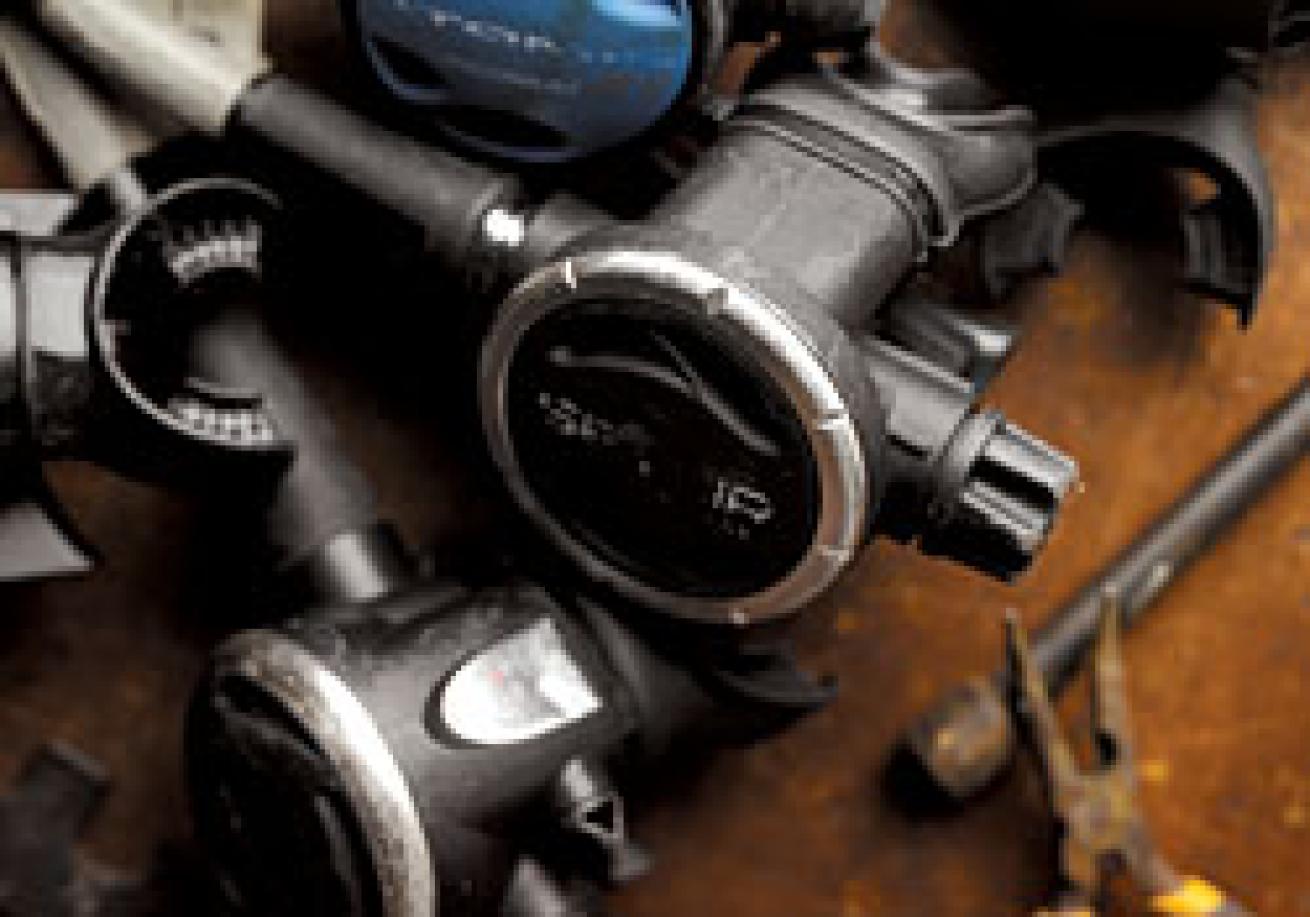
|
But what about durability? When mechanical products get more advanced, they often get more complex, which means there's more to go wrong. Does this apply to regulators? Scuba Lab decided to find out.
The Regs
||| |---|---|
| 30 Hours Aeris A1 Aeris Atmos Pro Atomic Aquatics T1x Dive Rite RG2500 Oceanic Alpha 8/SP-5 Oceanic GT 3/CDX-5 Tusa RS-460 50 Hours Atomic Aquatics B2 Atomic Aquatics T2| Genesis Scuba GS2000 Oceanic Delta 4/FDX-10 Sherwood Scuba Brut XS Scuba SeaAir Tri-Metal 100+ Hours Aeris Atmos Sport Atomic Aquatics M1 Atomic Aquatics Z1 Sherwood Scuba Oasis Tusa RS-110|The Challenge
In late 2004, we invited a number of reg manufacturers to participate in the first-ever long-term test of regulator durability. The response was overwhelmingly positive, so much so that we had more takers than we had available spots. In the end, we collected 18 regs that represented the range of breathers on the market.
To establish a baseline of performance, we first put them all on the ANSTI breathing machine. The ANSTI machine is an amazing tool, capable of measuring very minute differences in the work of breathing (WOB) at a variety of breathing rates and at a variety of depths. Specifically, it measures in joules per liter (j/l) the breathing resistance created by the regulator over the course of a complete inhale/exhale cycle. The lower the j/l measurement, the easier the reg breathes, but while the machine can measure performance differences as little as .01 j/l, the average human being probably can't discern a difference of less than .5 j/l.
Using a trimmed-down version of Scuba Lab's standard breathing machine protocol, we captured work of breathing data at two breathing rates/depth levels: 37.5 RMV at 132 feet (a somewhat aggressive breathing rate at the maximum recreational diving depth), and 62.5 RMV at 165 feet (the breathing rate and depth most commonly used by manufacturers to test regulators). In case you're wondering, RMV stands for respiratory minute volume, and the number represents how many liters of air are inhaled and exhaled in one minute.
Time to Get Wet
|| |---|
|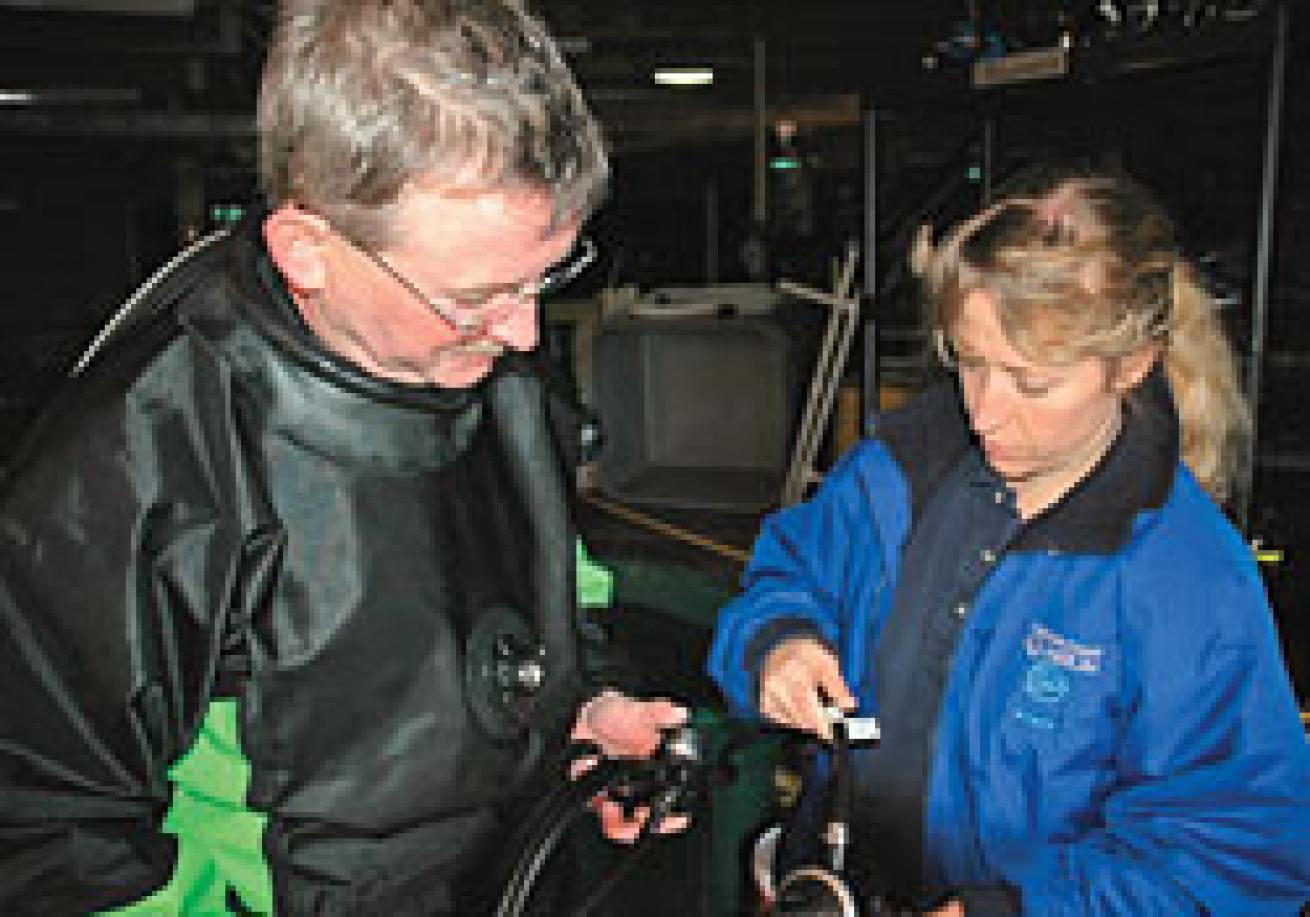
| | A volunteer checks out a test reg from Dive Safety Officer Vallorie Hodges.|
Hodges set up a tracking system that enabled divers to easily sign out a reg for each dive session and log the time the reg was actually used. After each dive session, the still-pressurized regs were soaked in a clean freshwater rinse tank (the tank water was changed daily) for 15 minutes. The aquarium divers used egg timers to track soak time and when the bell went off, the regs were rinsed under a gentle stream of fresh water before being depressurized and removed from their cylinders. The dust caps were dried with a towel and replaced on the first stages. Regs were then gently shaken dry and placed on grated shelving where they remained until the next time they were used. This soak/rinse process generally follows the standard after-dive maintenance instructions found in virtually all the manuals of our test regs.
Time's Up
For 18 months, the aquarium divers went about their duties, breathing the regs and logging the hours. When this phase was complete, Hodges assembled all data sheets, collected all the regs and sent everything back to Scuba Lab. We then went back to the ANSTI breathing machine and repeated the same panel of breathing tests as before to see if there was any change in performance. For our final step, we sent the regulators to the most qualified reg technician we know--George Perez, the owner of Sea Divers, in Ozark, Ala.--for a tear-down inspection and complete rebuild.
To help get a real-world handle on the following results from both the ANSTI machine and the rebuild bench, we divided the regs into three use categories defined by the number of hours accumulated during the in-water phase of the test.
30 hours: Representing a relatively active diver who might get out for a two-tank day of local diving once a month, and maybe take one dive vacation a year.
50 hours: Representing the more aggressive dive junkies among us who might spend a couple days a month sucking down two or three tanks each day, or take more than one dive vacation in a year.
100-plus hours: Representing the bona fide dive gorillas who seem to spend as much time underwater as they do on the surface (you know who you are).
The Results
On The ANSTI Machine
Virtually all regs experienced a small change, usually a reduction, in their first-stage intermediate pressure. This is to be expected, however, as normal wear and use takes its toll on the soft and hard seats--parts that are intended to be inspected and replaced during normal servicing.
Among the seven regs that logged approximately 30 hours, there was no substantial change in their work of breathing scores when compared to the pre-dive tests on the breathing machine. The one reg that did register a noteworthy change turned in a post-dive performance drop of less than half a joule. This is a small change that an average diver probably wouldn't be able to discern.
Among the six regs that logged approximately 50 hours, five turned in the same breathing machine performance before and after the 18 months at the aquarium. The sixth reg actually registered a slightly better performance. However, the improvement measured less than half a joule, which would not be noticeable to a typical diver.
Of the five regs in the 100 hours or more category, only two models experienced a performance drop that would have been detectable by a diver. Of these two, one showed seriously decreased performance due to mechanical difficulties in the first stage that were later corrected on the repair bench (see below). The other saw slightly diminished performance only in the most demanding ANSTI test and was brought back to its original performance level once it received long-overdue routine servicing. On the Rebuild Bench
In general, all of these regs held up very well, even those with well over 100 hours logged. Overall, the level of corrosion was minimal, ranging from none to light. No salt crystals were found in the internal components, and wear on the internal parts was generally considered to be acceptable. Wear and tear on hoses, mouthpieces, dust caps, and O-rings, etc., was also acceptable.
The most significant signs of wear were found on the two regs that logged the highest number of hours. One reg developed a thin but visible crack in its plastic second-stage case at the hose inlet, most likely the result of lateral stress on the hose or a hard blow to the case. While it did not affect breathing performance and wasn't noticed by the test divers, the cracked case presented a possible failure point and required replacement. The other reg experienced a rare but potentially serious problem with its first stage balancing system that made it unable to adapt to pressure changes on descent. In the shallow aquarium environment, test divers didn't notice a problem, but had they been diving any deeper, this reg's work of breathing would have quickly become extremely difficult and would have increased with every foot of depth. The problem was easily detected on the repair bench, but fixing it required a replacement part not normally included in the basic rebuild kit.
A half-dozen regs also showed some slack in their second-stage demand levers. While this could be the result of wear during the test, it could also be caused by improper factory adjustment, the nature of each reg's design or the use of too-weak springs. We did not tension-check each reg's demand lever prior to use, so we can't say for sure. In all cases, however, the slack was correctable on the rebuild bench.
The Bottom Line
Our first-ever regulator durability test added iron to two scuba maxims. One, a modern regulator is a rugged piece of equipment, able to provide reliable service for many hours of diving. Which brings us to maxim number two: Nothing has a greater impact on the life and well-being of your regulator than how you maintain it--after each dive and for the long haul.
The regs we turned over to Perez had more accumulated hours than the average recreational regs that cross his repair bench for annual servicing, yet they had fewer corrosion issues. The difference, he says, is the thorough soak and rinse they got after every dive. While our rinsing procedures are consistent with virtually all manufacturers' recommendations for post-dive care, let's be honest, they aren't consistent with what most of us actually do after a dive. Our advice: Take better care of your reg. A thorough soak and rinse will keep it at peak performance and increase its reliability.
Second, follow the manufacturer's recommendations when it comes to regular service intervals. For most of the regs on the market today, that means taking it to a qualified technician every 12 months (see the chart on p. 71). We skipped that service interval in the process of putting these regs to the test over an 18-month period, but that doesn't mean you should. The few performance issues we uncovered were all preventable with routine service.
In short, your regulator is your primary life-support system. Treat it with the respect it deserves, and you will protect your investment and maybe even save your life. But don't take our word for it. We now have test data to prove it.
The Testing Ground
|| |---|
|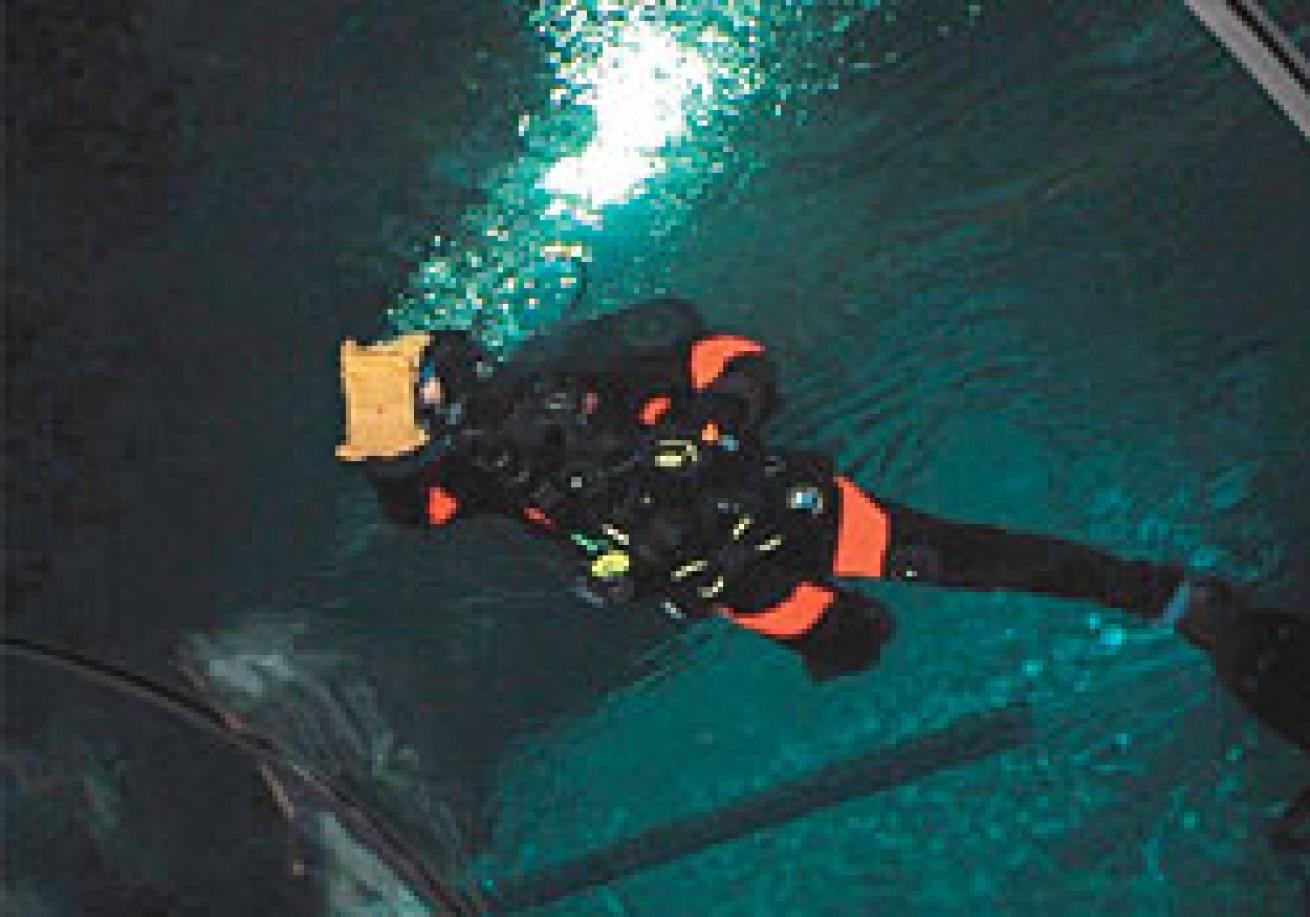
| | Cleaning the glass windows and observation tunnels is one of the labor-intensive chores that keeps volunteer divers busy.|
We thought you'd like to know a little bit more about the aquarium's volunteer divers. For starters, they all hold advanced open-water or higher certifications, and all had to complete the aquarium's four-day training course just to join the aquarium's dive team. On average, their one-way commute to the aquarium is about two-and-a-half hours, either through summer tourist traffic or blustery winter weather, just so they can spend the day assisting the aquarium's staff with the husbandry needs of the animals. This may include feeding fish, picking up waste, wiping down viewing windows, or mugging for the tourists who seem to enjoy watching the divers as much as they do the sharks, halibut, wolf eels, and variety of other animals. Even with all the chores that need to be done, the Oregon Coast Aquarium is still a fun dive. According to the volunteers, it's the bar-none best shore dive in the state, guaranteeing no shore break, good vis and lots of animals to swim with. For more on the Oregon Coast Aquarium, visit www.aquarium.org.
Manufacturer Warranty And Service Protocol
||||||| |---|---|---|---|---|---|
| Regulator Durability | | Manufacturer / Model| Recommended Service Interval| Warranty| Parts Program| First Stage Rebuild Kit Price* | Second Stage Rebuild Kit Price* | | Aeris A1 †| 12 months or 100 dives| 2-yr. ltd.| Free lifetime replacement parts program available.| $13-$15| $9| | Aeris Atmos Pro †| $20| $11| | Aeris Atmos Sport †| $20| $9| | Atomic Aquatics T2| 24 months or 300 dive hours| Ltd. lifetime| Free replacement parts for first two years.| $20| $12| | Atomic Aquatics T1x ††| $20| $12| | Atomic Aquatics B2| $22| $12| | Atomic Aquatics M1| $22| $12| | Atomic Aquatics Z1| $22| $12| | Dive Rite RG2500| 24 months or 100 dives| Ltd. lifetime| Free lifetime replacement parts available.| $29.06| $14| | Genesis Scuba GS2000| 12 months| Ltd. lifetime| Free replacement parts for first two years.| $20| $10| | Oceanic Alpha 8/SP-5 †††| 12 months| 2-yr. ltd.| Free lifetime replacement parts program available.| $12-$15| $10| | Oceanic GT 3/CDX-5 †††| $20| $10| | Oceanic Delta 4/FDX-10| $20| $11| | Sherwood Scuba Brut| 12 months| 2-yr. ltd.| Free replacement parts during term of warranty.| $8.50| Included in 1st stage price| | Sherwood Scuba Oasis| | Tusa RS-110 ††††| 12 months| Ltd. lifetime| Free lifetime replacement parts program available.| $18| $6| | Tusa RS-460| $28| $7| | XS Scuba SeaAir Tri-Metal| 12 months| Ltd. lifetime| No free parts program.| $18| $12| | * These are typical retail prices for the basic service kits. Prices may vary by repair facility and do not include additional items such as mouthpieces, packing lubes, shims, etc., that may also be required. Prices do not include labor charges. † The A1 is now available with or without a Dry Valve Technology (DVT) first stage. The Atmos Pro and Atmos Sport are now sold as the AT400 Pro and AT400 Sport, respectively, both with the AT400 first stage, which incorporates DVT. †† The Atomic Aquatics T1x is no longer in production. ††† The SP-5 first stage is available with or without DVT. The CDX-5 first stage now includes DVT. †††† The RS-110 will be replaced by the new RS-520 in 2007.|Regulator Warranties
One clear finding from this project is the importance routine maintenance can play in keeping your reg at peak performance. While these regs stood tall in the face of extended use, Scuba Lab still recommends you follow the manufacturers' recommendations for regular servicing. The small investment in maintaining your life-support gear can pay big dividends in performance. The suggested retail price of the replacement parts kits for the regs in this review ranges from about $10 to $45, but many warranties cover the cost of parts if you service your reg at the recommended intervals. Labor charges will vary.
How much labor is involved? It depends on the regulator design and the condition the reg is in when it comes into the shop. Here is the procedure George Perez used for this review and that he follows whenever a reg comes to his shop for annual service. Not every shop is this thorough, but maybe they all should be.
Annual service protocol
"When I start with a unit I check it externally for corrosion, cracks, and missing or misplaced parts. I remove the mouthpiece and place it in a sterilizing solution. I then attach the first stage to a cylinder valve adjusted to 3,000 psig. I record the intermediate pressure (IP) and then the Magnehelic reading of the cracking effort (CE). I then place the second stage on a Peter Built A.I.R. Flow analyzer and confirm the IP and CE, then check for water leaks.
"Next I review the individual regulator's service manual and note procedures for disassembling, cleaning, re-assembling and tuning. I then check the manufacturer's web site for any warnings, cautions or notices.
"The unit is then completely disassembled, while I make notes on corrosion and worn or broken parts. All parts are washed in soapy water (Dawn dishwashing liquid), and when necessary to remove corrosion, they are placed in an ultrasonic cleaner using Lawrence Factor Wash. After ultrasonic cleaning the parts are placed in a neutralizing solution, washed in water and blown dry.
"Assembly is performed per the instructions in the service manual, using the manufacturer's service kits.
"Preliminary tuning, in accordance with the manufacturer's data, is done at low pressure (500 psig) and then at high pressure (3,000 psig). The unit is then put on a Peter Built Quick Set Seat and Poppet fixture to break-in the high pressure (HP) and low pressure (LP) seats. After seat break-in, the second stage is placed on a Peter Built Pro Check fixture to check for leaks.
"Final tuning is performed with the reg immersed in water, and with the inhalation control knob (if applicable) and the Venturi switch set to the manufacturer's recommendation. The second stage is placed in the water in dive position (face down). The unit is adjusted until there are no leaks.
"After final adjustment, the unit is placed on the Peter Built A.I.R. Flow Analyzer to determine if it is performing properly. All tests are conducted at 500 psig and at 3,000 psig. The units are tested to an SCFM of 12.5. A high flow check (over 25 SCFM) is performed to determine demand lever action.
"After the checks are completed, the mouthpiece is replaced and the unit is placed in a sealed bag with a copy of the service report."
Which is More Durable?
Piston or Diaphragm First Stages? Conventional wisdom holds that diaphragm first stages, which are sealed off from contact with the surrounding water, will suffer less corrosion than piston first stages, which are directly exposed to water. Although our post-dive breathing tests and the subsequent rebuilds didn't uncover any major differences in the level of corrosion between piston and diaphragm first stages there is a logical explanation. First, the water in the Oregon Coast Aquarium is extremely clean. Second, our test divers followed a strict rinsing protocol. According to regulator tech George Perez, piston regulators used in clean water normally won't corrode any worse than diaphragm units. However, he does recommend diaphragm regulators for use in muddy, dirty or polluted water.
Brass, Stainless or Titanium? Perez didn't find significant levels of internal corrosion in any of the regulators regardless of the type of metal used. He feels that this is also due to the careful rinsing protocol. In the normal course of business, "the titanium units that I get in for repair are usually very clean. Rust or corrosion problems are generally nonexistent." The same can't always be said for stainless-steel or chrome-plated brass regs, especially in a saltwater environment where after-dive care is minimal. "Post-dive maintenance is the solution to your regulator's longevity," he says, no matter what it's made of.
Many Thanks
|| |---|
|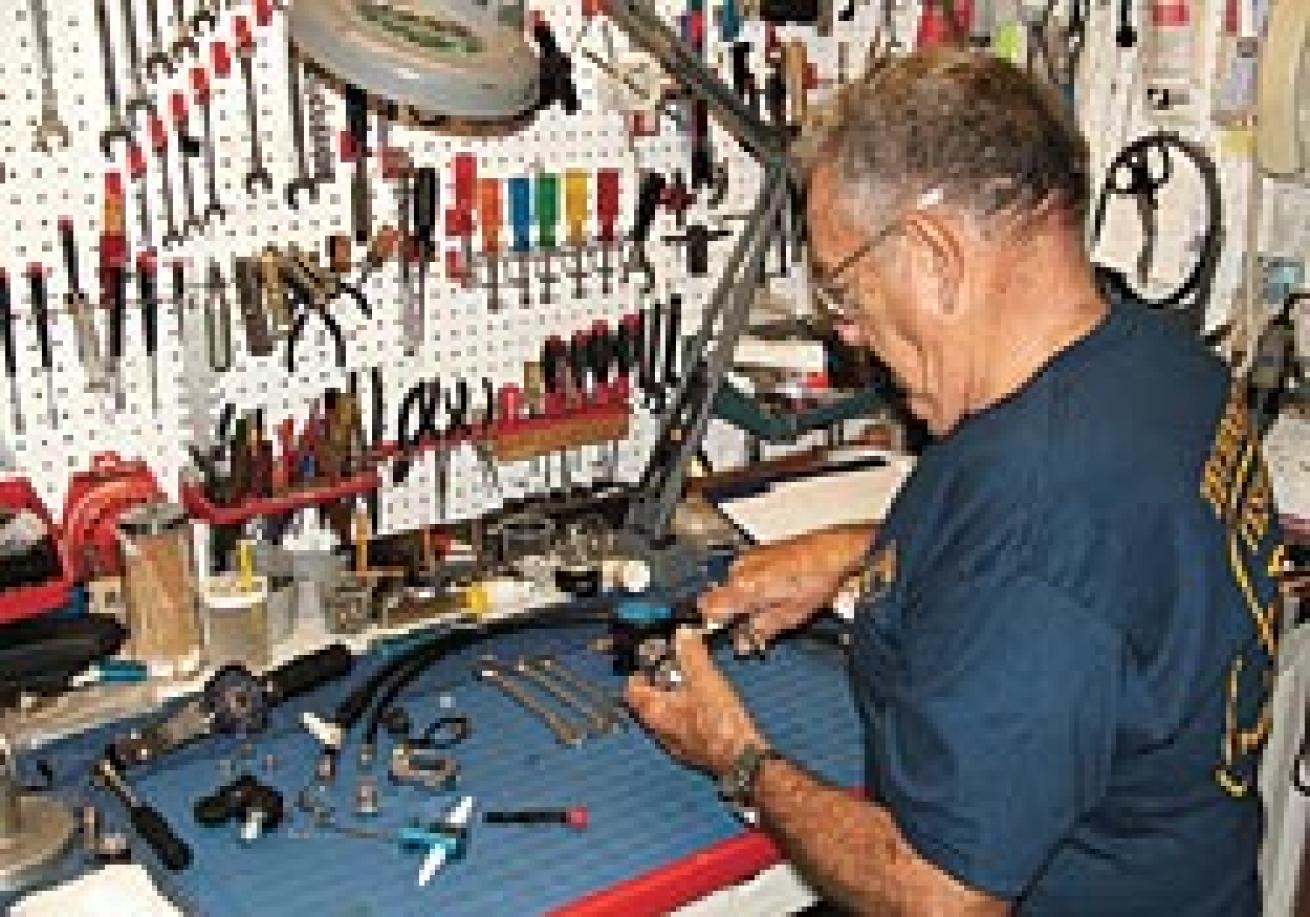
|
Sherwood Scuba (www.sherwoodscuba.com). The company not only submitted regs to be part of the test group, but also provided octopus regulators and SPGs for all of the test units in order to meet the aquarium's safety standards. At the conclusion of the test, this additional equipment was donated to the Oregon Coast Aquarium along with all of the test regs.
Mike Ward and Dive Lab (www.DiveLab.com) for running our pre- and post-dive ANSTI breathing machine tests.
Val Hodges and the divers at the Oregon Coast Aquarium (www.aquarium.org) for logging the hours on our test regs.
George Perez and Sea Divers (www.scubaseadivers.com) for inspecting and rebuilding the test regs.


